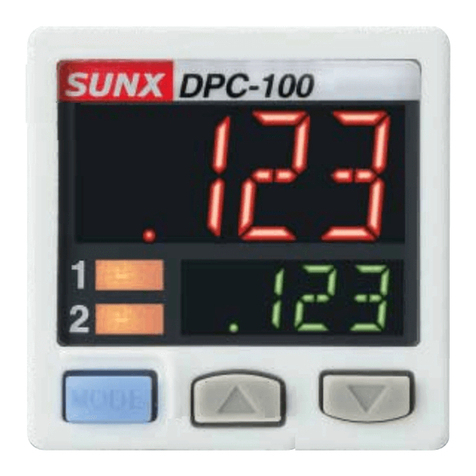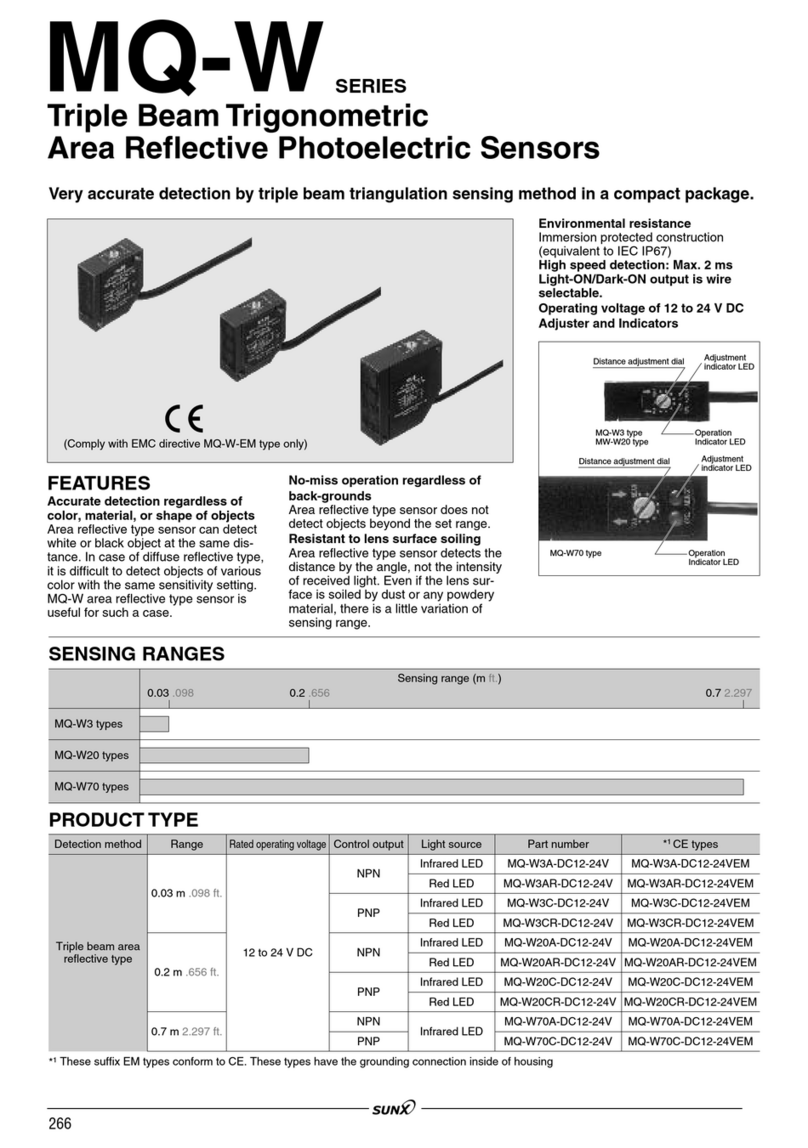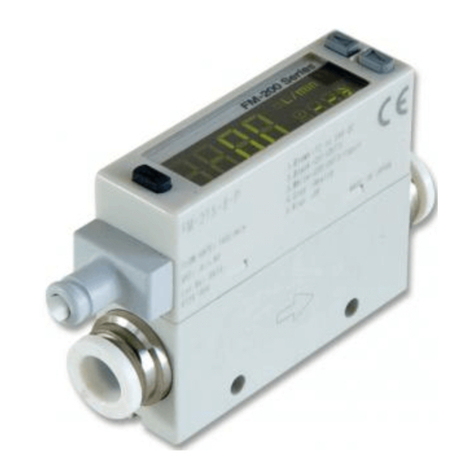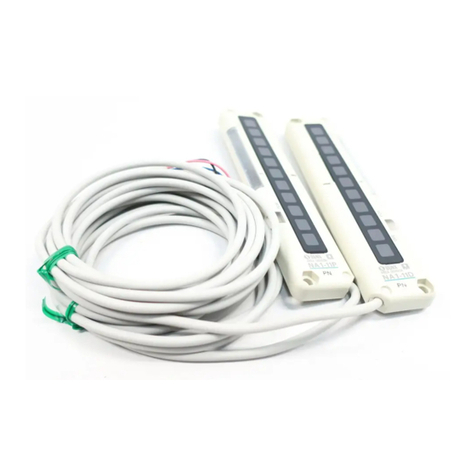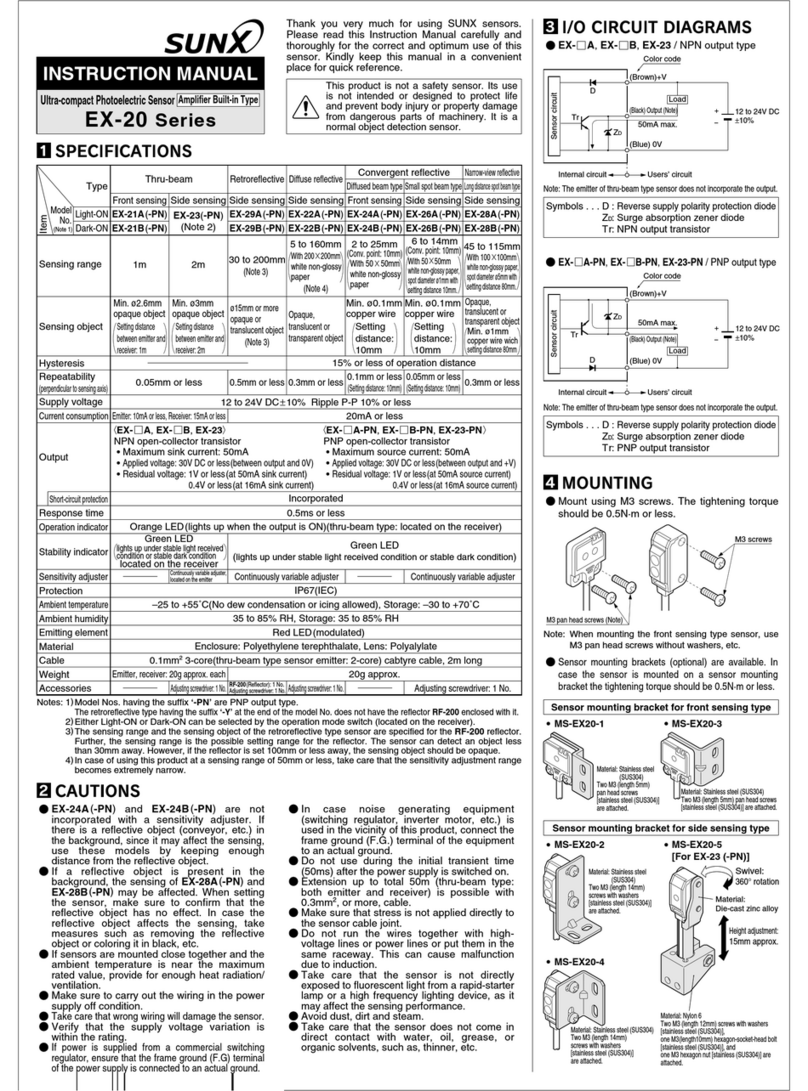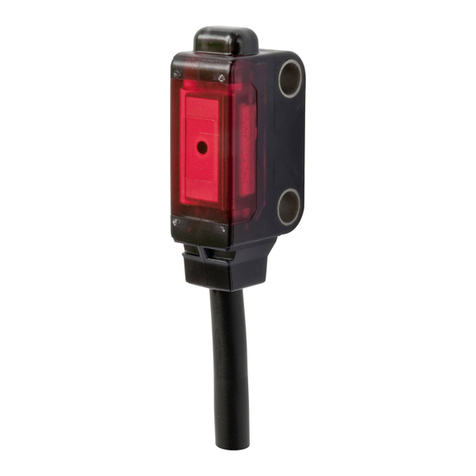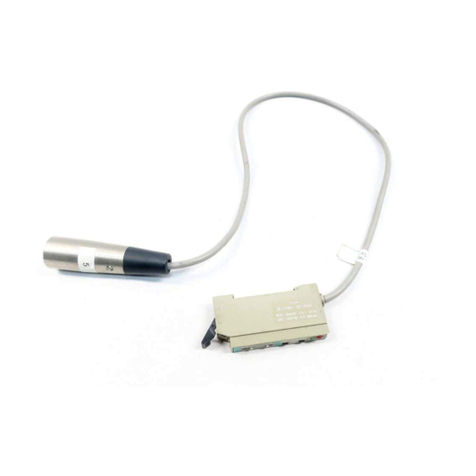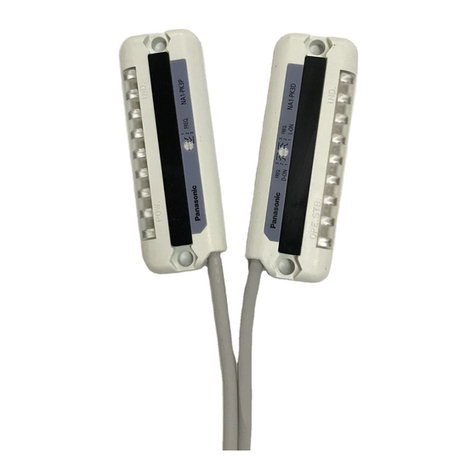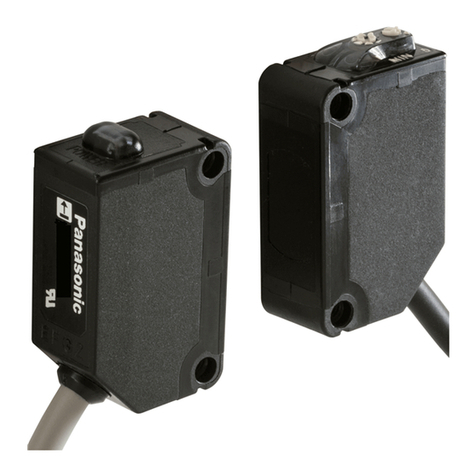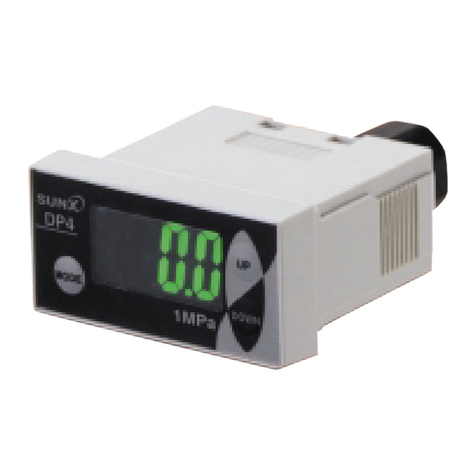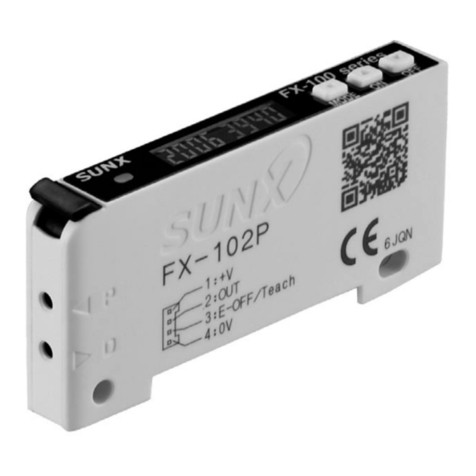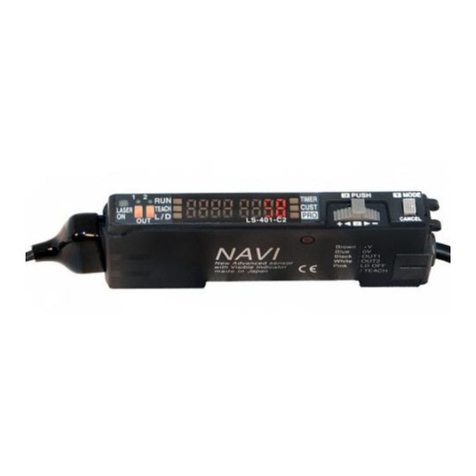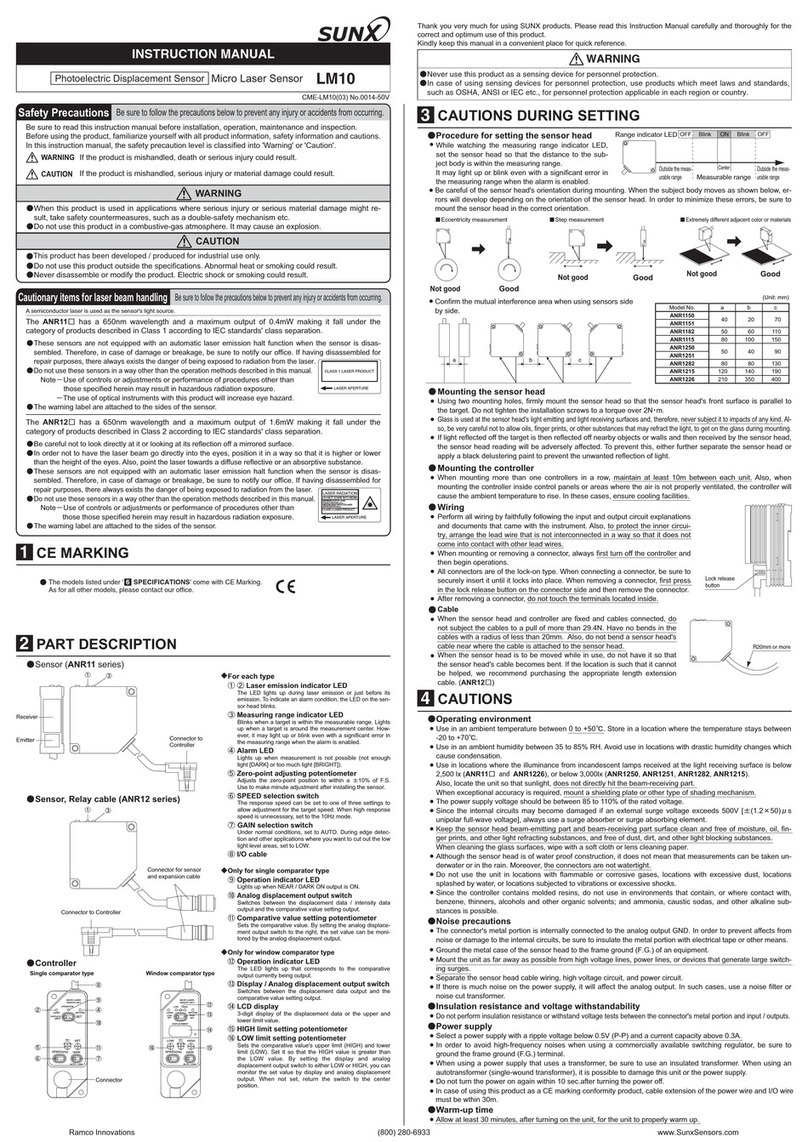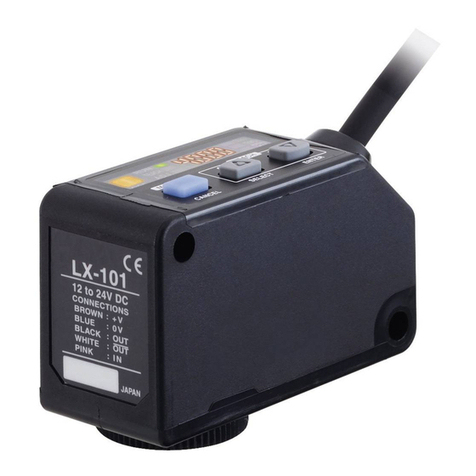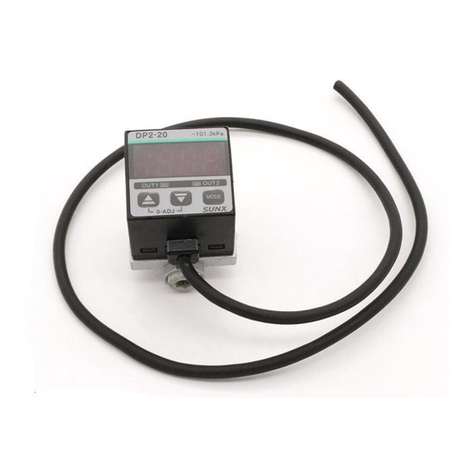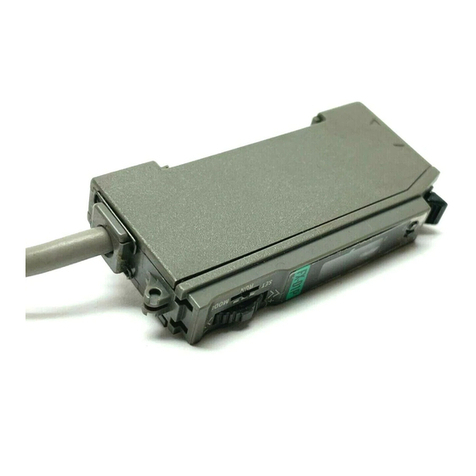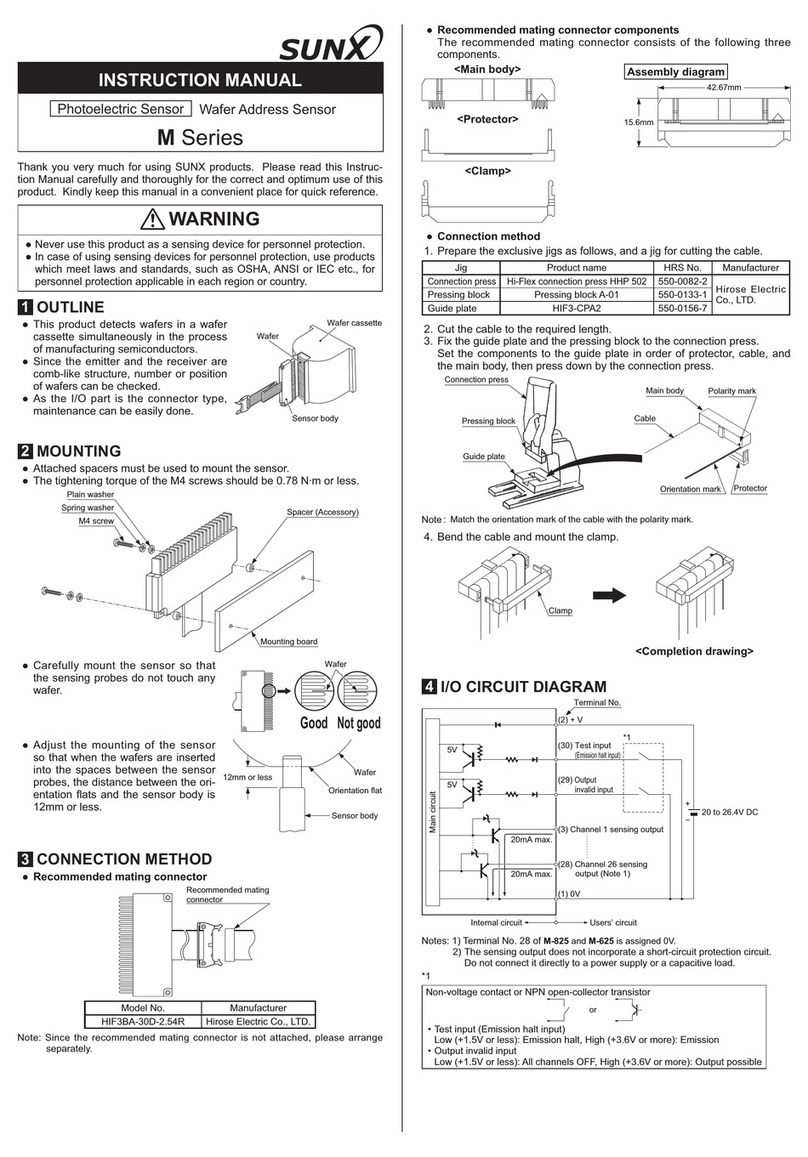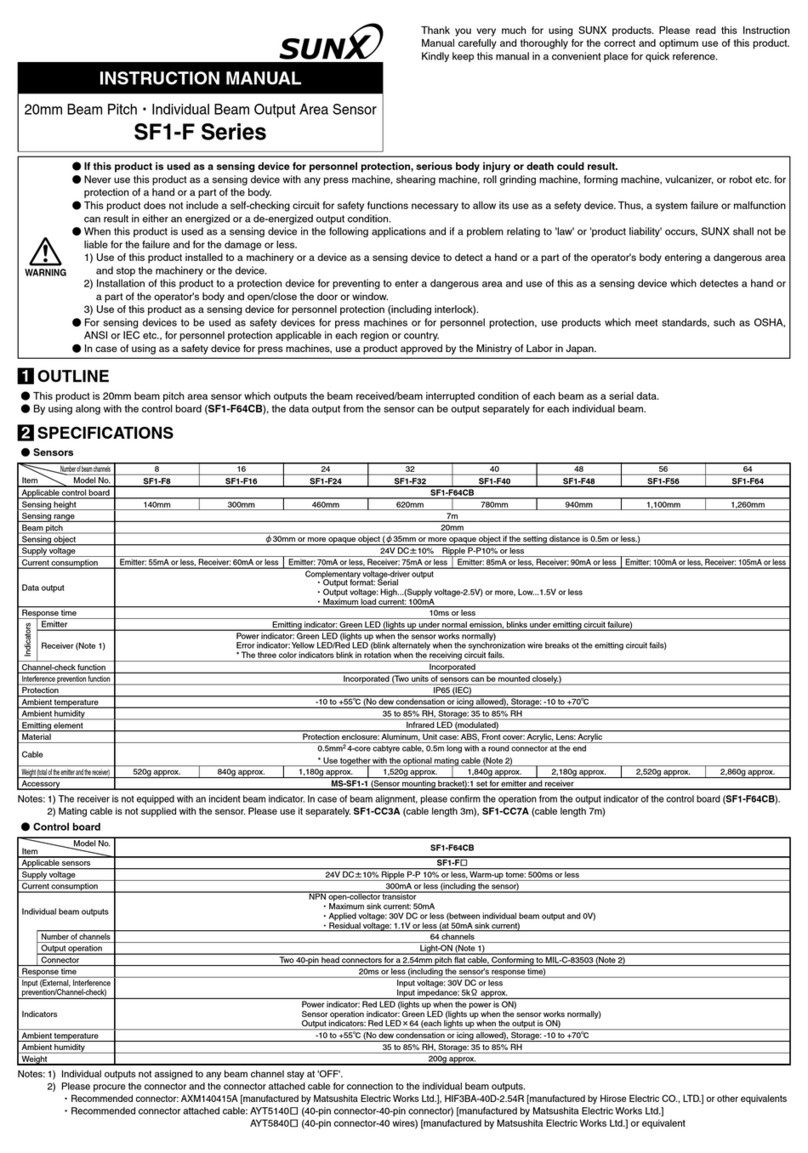
SPECIFICATIONS
1
CONNECTIONS
3
CAUTIONS
2
I/O circuit diagram
Wiring diagrams
When using one set of sensor
Emitter
Receiver
(Brown) +V +V
0V
21
34
+VSync.
0V
External
input
+VSync.
0V
Output
21
34
Connector pin positions I/O circuit diagram
Do not connect the synchronization wire to the ES terminal (external input) of
NPS or PS-930 sensor controller.
To supply power to the emitter and the receiver from separate power
supplies, be sure to connect both 0V (blue) wires in common and adjust both
the power supplies to the same voltage.
Notes: 1)
2)
Item
20mm
ø30mm or more opaque object (ø35mm or more opaque object if the setting distance is 0.5m or less.)
7m
SF1-N8-H
8
SF1-N8
140mm
SF1-N16-H
16
SF1-N16
300mm
SF1-N24-H
24
SF1-N24
460mm
SF1-N32-H
32
SF1-N32
620mm
SF1-N40-H
40
SF1-N40
780mm
SF1-N48-H
48
SF1-N48
940mm
SF1-N56-H
56
SF1-N56
1,100mm
SF1-N64-H
64
SF1-N64
1,260mm
500g approx.
630g approx.
840g approx.
1,080g approx.
1,170g approx.
1,530g approx.
1,500g approx.
1,990g approx.
1,830g approx.
2,440g approx.
2,170g approx.
2,900g approx.
2,500g approx.
3,350g approx.
2,830g approx.
3,800g approx.
12 to 24V DC±10% Ripple P-P 10% or less
Emitter: 55mA or less, Receiver: 60mA or less Emitter: 70mA or less, Receiver: 75mA or less Emitter: 85mA or less, Receiver: 90mA or less
Emitter: 100mA or less, Receiver: 105mA or less
Incorporated
ON when all beams are received/OFF when one or more beams are interrupted (OFF, also, when the sensor fails.) (Note 1)
Emitting indicator: Green LED
Operation indicator: Red LED (lights up when one or more beams are interrupted, and blinks when extraneous light is received)
Stable incident beam indicator: Green LED (lights up when all beams are received stably)
Unstable incident beam indicator: Yellow LED (lights up when one or more beams are received unstably)
The three color indicators blink in rotation when the receiving circuit fails, and blink simultaneously when the output circuit fails.
The operation indicator and the unstable incident beam indicator blink alternately when the emitting circuit fails or the synchronization wire breaks.
NPN open-collector transistor
• Maximum sink current: 100mA
• Applied voltage: 30V DC or less (between output and 0V)
• Residual voltage: 1.6V or less (at 100mA sink current)
12ms or less
35 to 85% RH, Storage: 35 to 85% RH
–10 to +55°C (No dew condensation or icing allowed), Storage: –10 to +60°C
Sunlight: 20,000 x at the light-receiving face, Incandescent light: 3,500 x at the light-receiving face
IP65 (IEC)
Incorporated
Incorporated
Infrared LED (modulated)
0.5mm24-core cabtyre cable, 0.5m long, with a round connector at the end
Use together with the optional mating cable
Protection enclosure: Aluminum, Unit case: ABS, Front cover: Acrylic, Lens: Acrylic
MS-SF1-1 (Sensor mounting bracket): 1 set
Output OFF condition
•
One or more beam are interrupted.
•
Either the emitting element, the emitting circuit, the receiving element, or the receiving circuit breaks.
•
Either +V wire, 0V wire, output wire, or synchronization wire breaks.
• Other components that the output transistor or the parts relevant to the output fail. (Note 2) • Some intense ambient light is received.
The output transistor can be checked by the test cantrol function.
Notes: 1)
2)
Color code
Connector pin No.
D
(Orange/Violet)
Synchronization
(Note 1)
(Brown) +V
(Black) Output
(Blue) 0V
100mA max.
Tr
ZD
Load
1
4
2
3
Internal circuit
Users' circuit
D(Brown) +V
Sensor circuitSensor circuit
(Blue) 0V
(Pink) External input
(Orange/Violet)
Synchronization (Note 1)
(Note 2)
3
4
1
2
+
–
12 to 24V DC
±10%
Internal circuit
Users' circuit
Connect both the synchronization wires.
Connect both the 0V wires in common.
Although both the +V wires need not be
connected in common, they must be at
the same voltage.
To use the test input function, connect a
switch between the external input wire
and 0V. If this function is not used, insu-
late the external input wire.
(Blue) 0V
(Pink) External input wire
(Orange/Violet) Synchronization wire
(Orange/Violet)
Synchronization wire
(Brown) +V
(Black) Output
(Blue) 0V
Color code
Load
Sensing height
Number of beam channels
Model No.
With spatter protection hood
Sensing range
Beam pitch
Sensing object
Supply voltage
Current consumption
Output
Test input function
Interference prevention function
Protection
Ambient temperature
Ambient humidity
Ambient illuminance
Emitting element
Material
Weight (total of the emitter and the receiver)
Accessory
Output operation
Short-circuit protection
With spatter protection hood
Emitter
Receiver
Indicators
Response time
Cable
lights up under normal emission, blinks under emitting circuit failure or on cable break between the synchronization and the external input
terminals when interference prevention function is used (only the emitting indicator of the Sensor B blinks), and lights off under no emission
Make sure to carry out the wiring in the power supply off condition.
Take care that wrong wiring will damage the sensor.
Verify that the supply voltage variation is within the rating.
If power is supplied from a commercial switching regulator, ensure that
the frame ground (F.G.) terminal of the power supply is connected to an
actual ground.
Do not run the wires together with high-voltage lines or power lines or
put them in the same raceway. This can cause malfunction due to
induction.
Do not use during the initial transient time (1.5 sec.) after the power
supply is switched on.
Do not use the sensor without the front cover or the enclosure. IP
protection cannot be maintained and a contact failure may occur
between modular units.
Avoid dust, dirt, and steam.
Take care that the product does not come in direct contact with organic
solvents, such as, thinner, etc.
Take care that the sensor is not directly exposed to fluorescent light from a
rapid-starter lamp or a high frequency lighting device, as it may affect the
sensing performance
.
This sensor is suitable for indoor use only.
Extension up to total 20m is possible with 0.5mm2, or
more, cable for both emitter and receiver.
Install the sensor where it cannot be affected by a
beam reflected from a machinery frame or a
workpiece. If the reflected beam is received, beam
interruption is not achieved.
The emitter and the receiver must face
each other corrctly. If they are set
upside down, the sensor does not work.
Make sure that stress is not applied
directly to the sensor cable joint.
When mounting the sensor, the tighten-
ing torque should be 2N·m or less.
Cable Cable
Cable
Sensing
object
Emitter
Receiver
EmitterReceiver
Symbols··· D
ZD
Tr
: Reverse supply polarity protection diode
: Surge absorption zener diode
:NPN output transister
Used for test input
function or interference
prevention function.
